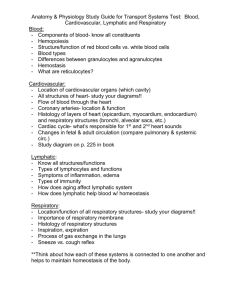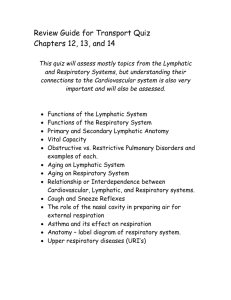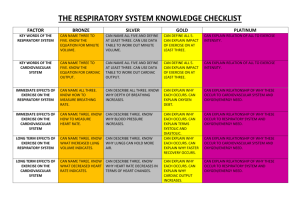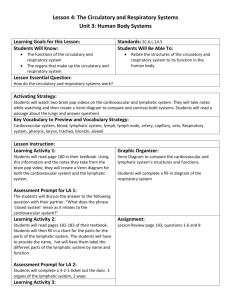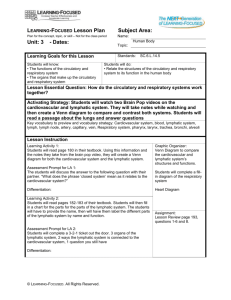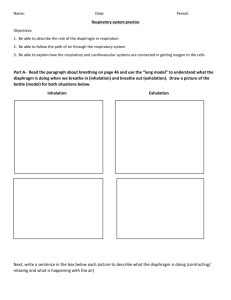Chapter 23
advertisement
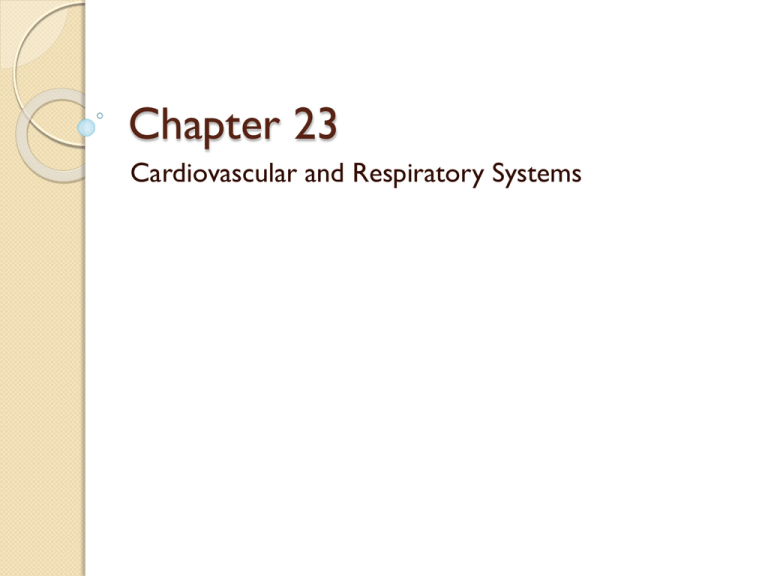
Chapter 23 Cardiovascular and Respiratory Systems Section 1: Objectives • List four main parts of the cardiovascular system, and describe their functions. • Describe the two types of circulation of blood in the body. • List four cardiovascular problems. Cardiovascular System • The cardiovascular system consists of the heart and the three types of blood vessels that carry blood throughout your body. • The blood vessels—arteries, capillaries, and veins—carry blood pumped by the heart. Cardiovascular System Your heart is an organ made mostly of cardiac muscle tissue. It is about the size of your fist and is almost in the center of your chest cavity. Cardiovascular System Cardiovascular System • Arteries are blood vessels that carry blood away from the heart and to the body’s organs. • Capillaries are tiny blood vessels that allow the exchange between body cells and blood. Cardiovascular System Veins are blood vessels that carry blood back to the heart. Cardiovascular System • Pulmonary circulation is the flow of blood from the heart to the lungs and back to the heart through the pulmonary arteries, capillaries, and veins. • Systemic circulation is the flow of blood from the heart to all parts of the body and back to the heart. Cardiovascular System Cardiovascular System Atherosclerosis happens when cholesterol builds up inside of the blood vessels. Artherosclerosis is a major cause of heart diseases. Cardiovascular System Hypertension is abnormally high blood pressure.The higher the blood pressure, the greater the risk of a heart attack, heart failure, kidney disease, and stroke. A heart attack happens when heart muscle cells die and part of the heart muscle is damaged. Heart failure happens when the heart cannot pump enough blood to meet the body’s needs. Section 1 Pop Quiz 1) List the 3 types of blood vessels. 2) List 1 place where cardiac muscle is located. 3) What is the difference between ateries and veins? 4) What is artherosclerosis? 5) What is hypertension? Section 2: Objectives • Identify the four main components of blood. • Describe three functions of blood. • Explain how blood pressure is measured. • Explain what the ABO blood types are and why they are important. Blood Components • • Blood is a connective tissue that carries gases, nutrients, and wastes through the body. Plasma is the fluid part of blood. • Plasma is a mixture of water, minerals, nutrients, sugars, proteins, and other substances. • Red Blood Cells Most blood cells are red blood cells (RBCs). • RBCs take oxygen to every cell in your body. Blood Components Platelets are pieces of larger cells found in bone marrow. When you cut yourself, platelets help blood clot. Blood Components • White Blood Cells (WBCs) help keep you healthy by destroying pathogens. WBCs also help clean wounds. • WBCs also keep you healthy by destroying body cells that have died or been damaged. Blood Components Your blood does more than supply your cells with oxygen and nutrients. It also helps regulate your body temperature. The force exerted by blood on the inside walls of arteries is called blood pressure. Blood Components Every person has one of four blood types: A, B, AB, or O. Your blood type refers to the type of antigens you have on the surface of your RBCs. Blood Components A transfusion is the injection of blood or blood components into a person to replace blood that has been lost. Blood type is an important consideration of a blood transfusion. Section 3: Objectives • Describe the relationship between the lymphatic system and the circulatory system. • Identify six parts of the lymphatic system, and describe their functions. The Lymphatic System The lymphatic system is the group of organs and tissues that collect excess fluid and return it to your blood. The Lymphatic System The smallest vessels of the lymphatic system are lymph capillaries. The fluid and particles absorbed into lymph capillaries are called lymph. The Lymphatic System • • • Bone Marrow is the soft tissue inside of bones. Bone marrow is where most red and white blood cells, including lymphocytes, are produced. Lymph Nodes are small, bean-shaped masses of tissue that remove pathogens and dead cells from the lymph. The Lymphatic System • The thymus is the gland that produces T cells that are ready to fight infection. • Your spleen is the largest lymphatic organ. • The spleen stores and produces lymphocytes. The Lymphatic System Tonsils are lymphatic tissue in the nasal cavity and at the back of the mouth on either side of the tongue. Tonsils help defend the body against infection. Section 4: Objectives • • • • Describe the parts of the respiratory system and their functions. Explain how breathing happens. Discuss the relationship between the respiratory system and the cardiovascular system. Identify two respiratory disorders. The Respiratory System • Respiration is the process by which a body gets and uses oxygen and releases carbon dioxide and water. • Breathing is only one part of respiration. • The second part of respiration is cellular respiration, which involves chemical reactions that release energy from food. • The respiratory system is the group of organs that take in oxygen and get rid of carbon dioxide. The Respiratory System Your nose is the main passageway into and out of the respiratory system. From the nose, air flows into the pharynx, or throat. The larynx is the part of the throat that contains the vocal chords. The Respiratory System The larynx guards the entrance to a large tube called the trachea, or windpipe. The trachea splits into two branches called bronchi. One bronchus connects to each lung. In the lungs, each bronchus branches into bronchioles, which branch to form thousands of tiny sacs that are called alveoli. The Respiratory System The Respiratory System Breathing is done by the diaphragm and rib muscles. The diaphragm is a dome-shaped muscle beneath the lungs. In cellular respiration, oxygen is used by cells to release energy stored in molecules of glucose. When you breathe, you take in oxygen, which diffuses into red blood cells and is carried to tissue cells. The Respiratory System The Respiratory System • Respiratory disorders include asthma, emphysema, and severe acute respiratory syndrome (SARS). • Asthma causes the bronchioles to narrow. An asthma attack may be triggered by irritants such as dust or pollen. • SARS is caused by a virus. Circulatory/Respiratory Concept Map Circulatory/Respiratory Concept Map
